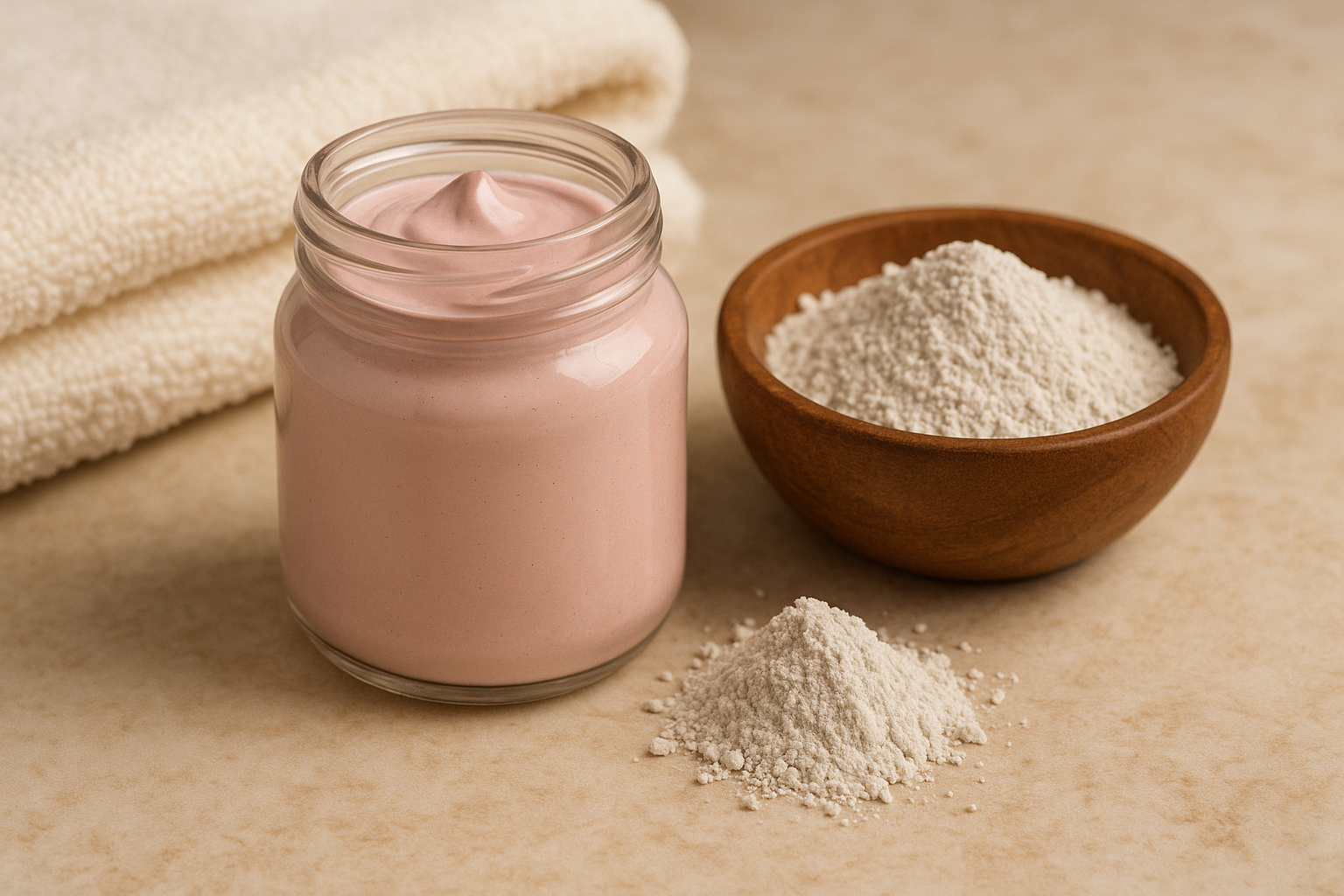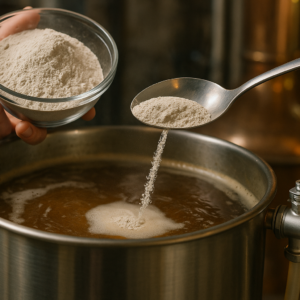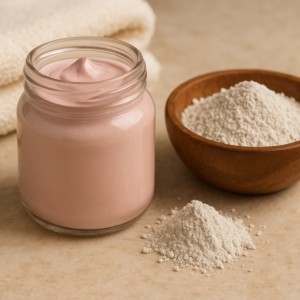If you’ve ever reached for that familiar pink bottle to soothe itchy skin, you’ve probably noticed the label says “shake well before use.” There’s a good reason for that instruction, and it all comes down to one special ingredient: bentonite. This natural clay mineral plays a role in keeping calamine lotion effective and easy to use.
Let’s break down why bentonite is such an important part of this classic remedy and what makes it work.
What Is Calamine Lotion?
Calamine lotion is a topical medication that people have trusted for generations to relieve itching and skin irritation. The U.S. Food and Drug Administration approves it as an over-the-counter skin protectant, and the World Health Organization lists it among essential dermatological medicines.
The lotion contains two main active ingredients: calamine (which is zinc oxide colored with ferric oxide) and additional zinc oxide. These ingredients give the lotion its signature pink color and provide the soothing, protective effects on your skin.
But active ingredients are only part of the story. Several inactive ingredients work behind the scenes to make the lotion function properly. These include glycerin, calcium hydroxide, and the star of our discussion: bentonite magma.
Understanding Bentonite: A Natural Clay Mineral
Bentonite is a type of clay that forms from weathered volcanic ash. Its primary component is montmorillonite, an aluminum silicate mineral with some remarkable properties.
What makes bentonite special in pharmaceutical applications? It has several standout characteristics:
- High swelling capacity: When bentonite meets water, it can expand to several times its original volume
- Colloidal properties: It forms stable suspensions in liquid
- Thixotropic behavior: It thickens when at rest but flows easily when shaken or stirred
- Large surface area: This allows it to interact with other substances effectively
Companies like CMS Industries manufacture pharmaceutical-grade bentonite that meets strict purity standards set by organizations like the U.S. Pharmacopeia and European Pharmacopeia. This ensures the material is safe for use in medicines and cosmetics.
Why Calamine Lotion Needs Bentonite
Calamine lotion falls into a category called “shake lotions.” These are liquid suspensions where solid particles (in this case, calamine and zinc oxide powders) are dispersed in a water-based medium.
Here’s the problem: these solid particles don’t dissolve in water. Left on their own, they would quickly settle to the bottom of the bottle, creating a hard, compacted layer that’s difficult to remix. That’s where bentonite comes in.
The Primary Role: Suspending Agent
Bentonite serves as the suspending agent in calamine lotion. When properly mixed into the formulation, it creates a stable environment that keeps the active ingredients evenly distributed throughout the liquid.
How does it work? When bentonite is hydrated (mixed with water), it forms what’s called a bentonite magma. This creates a gel-like structure that slows down the settling of the heavier zinc oxide and calamine particles. The particles remain suspended in this structure rather than rapidly sinking to the bottom.
According to pharmaceutical research, bentonite helps maintain what’s called the “sedimentation volume” of the lotion. This refers to the volume occupied by settled particles after the bottle sits undisturbed. A properly formulated lotion with bentonite will have a higher sedimentation volume, meaning the particles stay more spread out and are easier to redisperse with shaking.
Preventing Caking
One of the biggest challenges in suspension formulations is caking. This happens when settled particles pack together so tightly that they form a hard layer at the bottom of the container. Once caking occurs, no amount of shaking will properly remix the product.
Bentonite helps prevent this by creating loose, flocculated structures. Instead of individual particles settling into a dense mass, they form larger, porous clusters that trap liquid between them. These floccules settle more quickly than individual particles, but they create a loose sediment that’s easy to redisperse.
Studies comparing different suspending agents in calamine lotion have shown that bentonite-containing formulations maintain good redispersibility even after extended storage periods.
Thixotropic Properties
The thixotropic nature of bentonite is particularly useful for shaking lotions. At rest, bentonite creates a thick, gel-like consistency that holds particles in suspension. When you shake the bottle, the structure breaks down temporarily, and the lotion becomes fluid enough to pour and apply easily.
After you stop shaking, the gel structure reforms, thickening the lotion again. This behavior is reversible and can happen repeatedly without degrading the product. For calamine lotion, this means you get a product that’s stable during storage but easy to use when needed.
How Bentonite Compares to Other Suspending Agents
Pharmaceutical scientists have experimented with various suspending agents in calamine lotion formulations. Some alternatives include:
- Sodium carboxymethyl cellulose (CMC)
- Xanthan gum
- Natural gums like tragacanth or acacia
- Synthetic polymers
Each has its strengths, but bentonite offers a unique combination of benefits. Research published in pharmaceutical journals shows that bentonite provides good physical stability while being cost-effective and widely available. CMS Industries and other manufacturers produce bentonite in consistent grades that meet pharmaceutical standards, making it a reliable choice for formulators.
Some modern formulations use combinations of suspending agents to optimize performance. For example, mixing bentonite with carboxymethyl cellulose can provide benefits from both materials. The bentonite contributes its thixotropic properties, while the CMC adds viscosity and helps control sedimentation rates.
The Formulation Process
Creating calamine lotion with bentonite requires careful attention to the mixing process. The U.S. Pharmacopeia and British Pharmacopeia both provide official methods, though they differ slightly in their approaches.
The typical process involves:
- Preparing bentonite magma by hydrating bentonite powder in water
- Mixing the dry powders (calamine and zinc oxide)
- Combining the powders with glycerin to create a smooth paste
- Gradually adding the bentonite magma while mixing
- Adding remaining water and other ingredients
- Mixing thoroughly to create a uniform suspension
The proportion of bentonite must be carefully controlled. Too little won’t provide adequate suspension stability. Too much can make the lotion overly thick and difficult to spread on the skin. Pharmaceutical formulations typically use bentonite magma at concentrations around 40% by volume of the final product.
Quality Standards for Pharmaceutical Bentonite
Not all bentonite is suitable for use in medicines. Pharmaceutical-grade bentonite must meet rigorous purity requirements, including:
- Specific particle size distribution
- Controlled pH levels
- Minimal heavy metal content
- Low microbial counts
- Absence of harmful contaminants
Reputable suppliers like CMS Industries test their bentonite products to ensure they meet these standards. This quality control is important for patient safety and product consistency.
The bentonite used in calamine lotion should be colloidal hydrated aluminum silicate that swells appropriately in water and produces the desired suspending properties. Different types of bentonite exist (sodium bentonite versus calcium bentonite), and sodium bentonite is generally preferred for pharmaceutical suspensions due to its superior swelling characteristics.
Benefits of Bentonite in Calamine Lotion
The use of bentonite in calamine lotion provides several practical benefits:
For Manufacturers:
- Creates a stable product with good shelf life
- Allows for consistent batch-to-batch quality
- Provides cost-effective formulation
- Meets regulatory requirements
For Users:
- Ensures even distribution of active ingredients with simple shaking
- Provides appropriate viscosity for easy application
- Maintains product effectiveness throughout its shelf life
- Creates a smooth texture that spreads well on skin
For Pharmacists:
- Allows for preparation of extemporaneous formulations when needed
- Provides reliable performance with established methods
- Works well with other common pharmaceutical ingredients
Limitations and Considerations
While bentonite works well in calamine lotion, it’s not without some considerations. The lotion can have a slightly gritty feel when dried on the skin, which some people find uncomfortable. The powder component may clump and become abrasive after the water evaporates, so users should wash off residual particles before reapplying.
The pink color of calamine lotion may not be cosmetically acceptable for some situations, particularly when applied to exposed skin during the day. This is more of a concern with the calamine itself rather than the bentonite, but it’s worth noting as a practical limitation.
Bentonite-containing formulations also require proper storage. Extreme temperatures can affect the suspension stability, so the lotion should be stored at room temperature and kept away from heat sources.
The Future of Calamine Lotion Formulations
Pharmaceutical researchers continue to explore ways to improve calamine lotion formulations. Some studies have investigated combining bentonite with other suspending agents or replacing it partially with alternatives that might offer additional benefits.
For example, research has examined using natural gums or modern synthetic polymers alongside or instead of bentonite. These studies help formulators understand the trade-offs between different approaches and may lead to improved formulations in the future.
That said, bentonite remains a reliable, well-established ingredient with decades of safe use in pharmaceutical products. Its natural origin, biocompatibility, and effectiveness continue to make it a popular choice for calamine lotion and many other topical preparations.
Broader Applications of Bentonite in Pharmaceuticals
The role of bentonite extends far beyond calamine lotion. This versatile clay mineral appears in numerous pharmaceutical and cosmetic products:
- Antacid suspensions
- Pediatric liquid medications
- Tablet formulations (as a binding agent)
- Topical creams and gels
- Wound care products
- Detoxification supplements
In each application, bentonite’s unique properties serve specific functions, from binding tablets together to absorbing toxins in the digestive tract. The pharmaceutical industry values bentonite for its versatility, safety profile, and natural origin.
Practical Tips for Using Calamine Lotion
Understanding the role of bentonite can help you use calamine lotion more effectively:
- Always shake vigorously before each use. This breaks down the gel structure and redistributes the active ingredients evenly throughout the lotion.
- Check the consistency after shaking. The lotion should pour easily and have a uniform pink color throughout, not separated layers.
- Apply to clean, dry skin. The lotion works best when applied to properly cleansed areas.
- Let it dry completely before putting on clothing. The bentonite structure helps the active ingredients stay on your skin as the water evaporates.
- Wash off dried lotion before reapplying to avoid buildup of dried powder particles.
- Store properly at room temperature to maintain the suspension stability.
Frequently Asked Questions
Q1: Can I make calamine lotion at home without bentonite?
Making calamine lotion without bentonite is technically possible, but the result won’t be as stable or effective. The active ingredients will settle quickly and form a hard cake at the bottom of the container. If you want to try a homemade version, you’ll need to find another suspending agent like xanthan gum or carboxymethyl cellulose, though these may be harder to source and work with. For safety and effectiveness, using commercially prepared calamine lotion is your best option.
Q2: Is bentonite safe for skin application in calamine lotion?
Yes, pharmaceutical-grade bentonite is safe for topical use. It’s a natural clay that has been used in skincare and medical products for decades. The bentonite in calamine lotion is purified to pharmaceutical standards and doesn’t cause irritation for most people. Some individuals with very sensitive skin might react to any topical product, so stop using it if you notice increased redness or irritation. The bentonite itself is biocompatible and inert, meaning it doesn’t react chemically with your skin or the active ingredients.
Q3: Why does my calamine lotion still separate even with bentonite in it?
Some separation is normal and expected in shake lotions. Bentonite slows down settling and makes the particles easier to redisperse, but it doesn’t prevent all separation. If your lotion separates within minutes of shaking, or if you can’t get it to mix back together properly, it might be expired or improperly stored. Extreme temperatures can damage the bentonite structure. The lotion should remix to a smooth, uniform consistency with about 30 seconds of vigorous shaking. If it doesn’t, the product may have degraded and should be replaced.
Q4: What’s the difference between bentonite magma and bentonite powder?
Bentonite magma is what you get when you hydrate bentonite powder in water and let it swell fully. The powder consists of dry clay particles, while the magma is a gel-like suspension. In pharmaceutical formulations like calamine lotion, the bentonite magma is what actually gets mixed into the product. The magma form allows the bentonite to properly develop its suspending and thixotropic properties. Simply adding dry bentonite powder directly to calamine lotion wouldn’t work as well because it needs time and proper hydration to develop its functional characteristics.
Q5: Does the amount of bentonite affect how well calamine lotion works?
The bentonite concentration affects the physical properties of the lotion but doesn’t change the therapeutic effectiveness of the active ingredients (zinc oxide and calamine). What it does affect is how well the lotion stays mixed, how thick it feels, and how easily it spreads on your skin. Too little bentonite means poor stability and rapid settling. Too much makes the lotion overly thick and difficult to apply. Pharmaceutical formulators carefully balance the bentonite content to get the right consistency and stability. The standard formulations you buy have been optimized through years of research and testing.







